July 20, 2015
“For our entire lives, Pluto was nothing more than a dot in space and now it’s an entire world, with surface features and personality and – Oh my God! – this section right here looks like a heart! It hearts us!”
~ Stephen Colbert

“A person’s a person, no matter how small.”
Many of us remember that phrase from a childhood reading of Horton Hears a Who, by Dr. Seuss. In the classic children’s tale, the compassionate and egalitarian elephant Horton is enjoying a dip in the local pool when he hears a tiny call for help coming from a small dust speck floating by in the air. Worried that the dust speck would land in the pool, thereby drowning all the inhabitants of the tiny world it represented, Horton takes it upon himself to keep the dust speck safe by carrying it around with him on a piece of clover, enduring ridicule and persecution by those around him, who cannot believe a world that small could possibly exist. Everything turns out alright in the end, though, and Horton and “the Whos” (the inhabitants of the tiny, dust-speck-sized world) finally achieve recognition for Who-ville and themselves.
In 2006, when a group of astronomers decided to demote Pluto from planet to dwarf planet, I was one of those who took it personally. I grew up with Pluto as the 9th planet in our solar system. It seemed so mysterious; after all, Pluto was named after the Roman god of the underworld. Astrologically, the planet is associated with the sun sign Scorpio. Those born under that sign, at the very least, like to appear mysterious. The planet has also been, until very recently, literally mysterious; astronomers knew very little about Pluto.
That began to change on Monday July 13, when NASA’s New Horizons spacecraft snapped this historic photo of Pluto just before making its closest approach to the planet on the next day. New Horizon’s 10-year, nearly 3 billion mile journey is providing data to scientists that will nourish discovery for years to come. Already we know that Pluto’s now-famous “heart” contains a region of ice and that, at 1,473 miles (2,370 kilometers), the planet is larger than previously estimated.
New Horizon’s visit has generated excitement beyond the world of science. Earlier this month, the classic rock band Styx recently met with the New Horizons team. The band members were the autograph seekers this time; they got a poster of Pluto and its moons autographed by Dr. Mark Showalter of the SETI institute, who discovered Pluto’s smallest moon, also named Styx, in 2012.
Stephen Colbert recently sat down with astrophysicist Neil deGrasse Tyson to argue the need to restore Pluto’s full planet status. Dr. Alan Stern, principal investigator for the New Horizons mission, agrees. In a recent interview for Spaceflight Now, he talked about how he hopes that when people see the images from the flyby, they will think of Pluto as a planet:
“I see it every day, now that people are seeing pictures of a world with moons going around it, and surface features on it, and they don’t know what else to call it. I don’t think the astronomers will ever catch up. I think they have so badly damaged their own reputation that people are just going to make fun. I think that’s the most likely outcome. Meanwhile, in planetary science, we just call it a planet. We don’t care what the astronomers say.”
I agree with Dr. Stern.
A planet’s a planet, no matter how small.
~~~~~~~~~
The other day I was treated to the small, unexpected beauty of my chive plant covered in tiny purple blossoms. Crespelle with Cheese and Chive Blossoms was the delicious result.

Crespelle with Cheese and Chive Blossoms
Crespelle are a form of Italian crepe. They make an elegant and simple appetizer or a meat-free main dish when served with a simple green salad. I like to use pastured eggs, such as Vital Farms, to ensure I’m cooking with healthy eggs from happy hens.
1/4 cup chopped chive blossoms
5 tablespoons all-purpose flour
1/4 cup Parmesan cheese, divided in half
Extra virgin olive oil (about 1/2 cup, mostly for cooking)
6 eggs
1 cup spring water
Freshly-ground pepper, to taste
1/2 to 3/4 cup grated cheddar cheese
Additional chive blossoms, for garnish
In a medium bowl, whisk chopped chive blossoms, flour, half of the Parmesan, 1 tablespoon of the olive oil, eggs, water and pepper until smooth. Heat a large, non-stick skillet (I used a 12-inch) over medium-high heat. Add enough olive oil to completely coat the surface of pan. When oil is hot, pour 1/2 cup of the batter (less if using a smaller pan) into the skillet and quickly tilt the pan around to coat it evenly and completely with the batter. Cook the crespella until golden on the bottom, 1 to 2 minutes. Flip to other side (I never learned to flip in the pan, so I used a large spatula for this). Cook other side 1 minute, or until golden; transfer to a plate. Sprinkle surface with 2 tablespoons or so of the cheddar and roll into a cigar shape. Keep warm in a low temperature oven or toaster oven while you continue cooking the remaining crespelle. Add a bit more oil, if necessary as you go, to ensure the surface of the pan stays coated.
To serve, garnish with reserved chive blossoms, remaining Parmesan and a pinch of freshly-ground pepper.
Makes 5 or more crespelle, depending on pan size.
Posted in Uncategorized | Comments Off on Heart Shaped World |
July 8, 2015
“Always remember, your focus determines your reality.”
~ From Star Wars: Episode 1 – The Phantom Menace (1999)

“A long time ago in a galaxy far, far away.”
This signature phrase from the opening of every Star Wars film, tells of a futuristic time and place in the distant past. The language brings to mind a time period far removed from our own, an age that would make medieval times seem relatively recent.

Fans of the movies will recognize a striking similarity between Jedi Master Yoda and the strange figure drawn between the paragraphs in the image above. However, this pointy-eared creature in monk’s robes is actually from a medieval manuscript created in southern France between the year 1300 and 1340. Known as the “Smithfield Decretals”, the text and image were featured a few months ago on the British Library’s Medieval Manuscripts blog.
Yoda seems to be existing in multiple time periods at once. I know the feeling. For many of us, finding and maintaining an awareness of the “now” can be elusive.
With all of the information coming at us from numerous sources these days, it can be difficult to keep our minds and emotions from wandering between past events and future possibilities. Amid the everyday chaos, how does one achieve and maintain mental and emotional equilibrium?
A useful technique for keeping your focus in the now is a yogic practice known as drishti. Drishti is a Sanskrit word meaning “vision”, “sight”, “gaze” or “perception”. In the context of yoga it refers to maintaining a fixed gaze on a single point. For example, when in standing balance poses, such as mountain pose, or tree pose, I recommend that my students find a fixed point in the distance to softly focus on. Gazing at a single, unmoving point helps one align oneself physically and mentally with its stability.
You don’t have to be a yogi to practice drishti. Taking a few moments to find and maintain a soft focus on a single point, even for a few minutes, can help one find balance in the midst of a stressful and chaotic day. Here’s how:
Stand with your feet about hips distance apart, arms at your sides, shoulders back and neck softly lifted. Tuck in your abdominal muscles to support your back. Alternatively, you could find a comfortable seated position, arms resting in your lap, sitting up straight with shoulders back and neck softly lifted. Breathe slowly and deeply, in and out through the nose, if possible.
Find a fixed point in the distance in front of you to softly focus on. This is your “now”. Let everything else around this point blur. Do this for at least 3 minutes, whenever you feel scattered.
Once you master the technique of maintaining a soft gaze on a single point of focus, I recommend taking it outdoors. Go to the park, the beach or even your backyard and stop to gaze at a leaf on a tree, a pebble on the ground or the single petal of a flower. Practicing drishti in this way can be a path to seeing the Divine in all things, big or small, animate or inanimate.
Whether you are standing in the forest or sitting in your office, this simple exercise can become a tool for achieving both a real and metaphorical focus of vision. In Star Wars: Episode IV – The Empire Strikes Back, Luke asks his teacher how he will know the good side from the bad. Master Yoda replies:
“You will know when you are calm, at peace, passive.”
Whether we seek physical, mental, emotional, energetic or spiritual equilibrium, the present moment is always a good place to start – even if you are living a long time ago in a galaxy far, far away.
~~~~~~~~~
Fresh, ripe strawberries are plentiful now. Freeze the extras to make Strawberry Basil Slushies anytime.

Strawberry Basil Slushies
This sophisticated slushy makes for a refreshing apéritif on a hot afternoon.
12 ounces frozen organic strawberries*
1/2 cup organic sugar
1/2 cup chopped fresh basil leaves (loosely packed)
1 cup sparkling water
*This amount of frozen strawberries looks like 3 cups in the blender and a heaping 2 cups inside a measuring cup.
Place frozen strawberries in blender. Sprinkle sugar on top and let sit for 5 minutes or so. Add basil and sparkling water and blend until smooth (you may need to pulse, stop and stir a couple of times in the beginning).
Serves 2 to 4
Posted in Uncategorized | 1 Comment » |
June 26, 2015
“Flowers don’t worry about how they’re going to bloom. They just open up and turn toward the sun, and that makes them beautiful.”
~ Jim Carrey

Just outside the yoga deck, hidden within a secret garden, at Sunflower Retreats.
Happy Belated Summer Solstice!
Regular Philosopher’s Spoon readers may have noticed that my posts have been less frequent during the past few months. This has been due to a period of particularly intense, challenging and exciting events in my life during the spring of 2015.
First of all, I moved to a new house, accompanied by all of the searching, packing, planning and general upheaval that comes with a change in abode. In addition, all of this relocating activity was happening at the same time that I was preparing for a three week trip overseas to teach yoga.
I have just returned from Italy, where I was lucky enough to say goodbye to the spring season at Sunflower Retreats, a yoga holiday destination in Casperia, a medieval hill-top village, located about an hour north of Rome.
I spent two inspiring weeks with wonderful visiting yogis; the warm and gracious owners of Sunflower, Lucy and Alan; the onsite therapist Ciara and her contagiously happy dog Henry; and the amazing Addie, who made sure everyone was happily nurturing their chakras and having a wonderful time.
I ended my trip by welcoming the first day of summer in the eternal city of Rome.
I am still a bit jet-lagged and overwhelmed. But I thought I would share a few photos from my adventures:
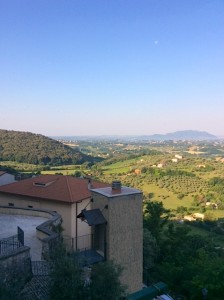
Above is an early morning view from my apartment in Casperia, the hilltop village where Sunflower Retreats is located.
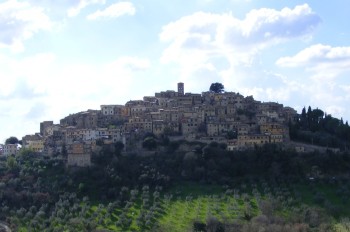
There I walked up and down the ancient steps of the town, from my apartment to the yoga deck, to the local grocery store, and often to the insanely good local restaurant, Osteria Vigna.
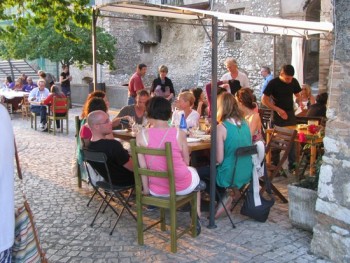
Vigna is co-owned by an English expat and an Italian trekker and Star Wars nerd. During one of my visits, I noticed that his cellphone ringtone was Darth Vader’s signature breathing, the sound of which can seem coincidentally similar to the that of “Ujjayi Breath” a technique common in yoga practices. A life-sized cutout of Spock giving the Vulcan Salute stands in the bar area, and greeted me as I enjoyed superb dishes such as ravioli with ricotta, lemon and sage; a feather-light carrot flan and a scrumptious gelato ball covered in white chocolate and drowned in espresso.
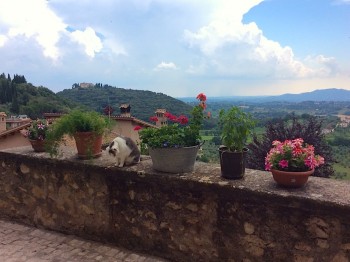
Cats are everywhere in Casperia, as well as beautiful views. The photo above is from one of my walks to the local grocery store, where I bought fresh zucchini flowers and a wonderful mozzarella. I sautéed the flowers in olive oil until tender and added them into hot fusilli pasta, along with chunks of the cheese. Stirring all of this together soon caused the melted cheese chunks and flowers to join together, creating a large, chewy ball of mozzarella and tender zucchini flowers sitting in the center of al dente pasta; it was delicious nonetheless.
I also found ready-to-fill mini cannoli shells at the market, which I stuffed with a mixture of smooth ricotta, mascarpone, cherry preserves, lemon zest, sugar and cinnamon. I shared a bit of this inspiration from my Sicilian ancestors with some of the staff and guests at the retreat.
My time teaching at Sunflower Retreats was unforgettable.

This gnome, outside another local restaurant, greeted me with both a fist bump and a thumbs up sign. Just one of Casperia’s friendly locals, he seemed to be saying, “Torna presto!” (come back soon).
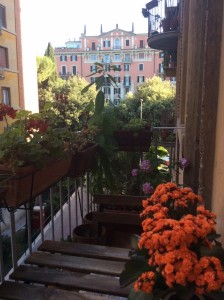
From Casperia I ventured to Rome for the last part of my trip. There I enjoyed this view from the balcony of my apartment, a comfortable VRBO located in the fashionable Prati neighborhood. In the mornings I would have coffee; in the afternoons I would savor the rare treat of Coca Cola made according to the original recipe: with sugar, instead of the corn syrup that is now used in the United States production of the famous soft drink.
I had an amazing authentic Roman lunch at Da Enzo al 29, courtesy of my companion and authentic Roman, Paolo.
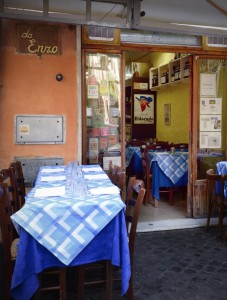
Da Enzo’s food was a revelation. From the creamy burrata cheese served with basil, baby tomatoes and olive oil;
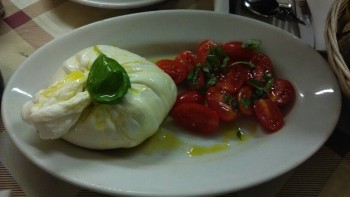
to the Carbonara (rigatoni with guanciale, a cured pork specialty from central Italy, pecorino cheese, and a velvety sauce of organic eggs);
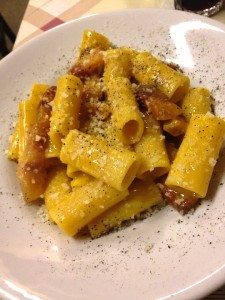
to the heavenly dessert, a feather-light mascarpone mouse, made with organic eggs and tiny, wild strawberries:

While enjoying this incredible meal, I overheard a conversation at the next table, occupied by a group of men who had traveled to Rome from northern Italy, planning to protest the idea of gay marriage. Apparently, they were upset because another group had shown up to their event to protest them.
I thought of those men today, when the historic U.S. Supreme Court decision was announced that gay marriage is a constitutional right, guaranteeing the ability of same sex couples to marry, throughout all of the United States.
If I were sitting next to them at this moment, I would turn and offer them a translation of our President’s words today on Twitter, “l’amore vince!”
Love wins!
~~~~~~~~~
Fusilli with Sunflower Seeds, Parsley and Parmesan was created one evening during my stay in Casperia.

Fusilli with Sunflower Seeds, Parsley and Parmesan
I bought the ingredients for this dish, intending to make a sunflower pesto. Upon realizing that I had no food processor or mortar and pestle, I decided to simply toss the ingredients together. The result was simply delicious.
Ingredients:
5 or 6 cups of hot, cooked fusilli pasta, cooked al dente
(about 8 to 10 ounces dry)
1/2 cup of extra virgin olive oil
1 small clove of fresh garlic
1/3 cup of raw unsalted sunflower seeds
1/2 cup of chopped parsley, slightly packed
Zest of half a lemon
1 teaspoon fresh lemon juice
3/8 cup finely grated Parmesan cheese, plus more for the table
Place olive oil inside a large bowl.
Cut grooves into garlic clove and smash with a fork into the oil, releasing the flavor. Stir well and discard the smashed clove.
Add the sunflower seeds, Parmesan, parsley, lemon zest and lemon juice.
Toss with hot cooked pasta and serve immediately.
2 to 3 servings
Posted in Uncategorized | 4 Comments » |
May 18, 2015
“When we quit thinking primarily about ourselves and our own self-preservation, we undergo a truly heroic transformation of consciousness.”
~ Joseph Campbell

When most people think of the word metaphysics, the common meaning that comes to mind is “beyond physics” or “the study of what lies beyond the physical world”. However, the origin of the word was as a title of a work by Aristotle, the famous Greek philosopher, and the original meaning was all about location, location, location.
The word metaphysics was first used by Andronicus of Rhodes, another Greek philosopher, who lived in the 1st century BC. Rhodes is known for editing, organizing and publishing Aristotle’s original texts. Meta is a Greek preposition meaning 1) “after, behind” or 2) “changed, altered” or 3) “higher, beyond”. Prepositions are words that indicate location (such as on, in or beside). Rhodes added the preposition meta to the noun physics, merely to indicate the book’s position in the collection. He named this particular work Metaphysics, not because it addressed subjects of a lofty and spiritual nature, but simply because this particular work happened to be “the book that comes after the book titled Physics”.
The modern understanding of the term as “the science of that which transcends the physical” with all of its mystical, philosophical and new age associations, is the result of a misinterpretation of Rhodes’ title of this particular work of Aristotle by Latin writers in later centuries.
It is actually ironically appropriate that the word’s original meaning was changed over the centuries. The second definition of meta is “changed, altered”. Therefore, many words containing this element indicate transformation. The Greek word metabole, which our word “metabolize” came from, means “transmutation” or “the act of changing or the state of being changed into another form.”
Transmutation was/is the goal of spiritual alchemy. Think of the Prayer of St. Francis: “Where there is hatred, let me sow love; Where there is injury, pardon; Where there is doubt, faith…” The ability to go within and change sadness into joy, sickness into healing, stubbornness into surrender and fear into faith creates in one’s heart the true philosopher’s stone, capable of transforming (spiritual) lead into (spiritual) gold.
The transformative power of gratitude was/is the basis for The Philosopher’s Spoon, the title of this blog and the original book it was based on. After years of dieting with little or no results, I found that by simply giving thanks before each meal, my relationship with food was transformed and, as a result, my digestion, my choices, my weight and my life were transformed as well.
Here is what I say before each meal:
Thank you to the plants, animals and people who gave their lives, time and energy to bring me this delicious, nutritious and healing food. Help me transform this gift of life into a blessing that I can share with each person I meet and each, in turn, who is touched by them.
Maybe some of you will choose to give saying thank you before each meal a try. Whether the results are physical or beyond the physical, may this practice bring you joyful transformation.
~~~~~~~~~
A regular Philosopher’s Spoon reader requested this lip-smackingly delicious recipe for Horiatiki (Greek Salad) Tacos, which was featured in the July 22, 2013 blog post.

Horiatiki Tacos with Marinated Feta
Greek Salad (Horiatiki Salata) makes a delicious filling for this super-tasty, virtually no-cook summer meal. This is a vegetarian-friendly recipe, but you can add cooked shrimp as a variation for pescavores. Make the Marinated Feta one day to one week ahead.
Tacos:
1 clove of garlic, smashed
1 (15 oz) can organic garbanzo beans, drained and rinsed
2 tablespoons fresh lemon juice (plus more to taste)
1/2 teaspoon crumbled dried oregano
Salt and freshly ground pepper to taste
2 green onions, trimmed and chopped (green & white parts)
1 cup finely chopped bell pepper
1 cup diced cucumber
2 cups diced ripe heirloom tomatoes
8 (approximately 7″ flour tortillas or lavash-style flatbreads)
Marinated Feta (recipe below)
Optional:
1 (16 oz) package of frozen, cooked, peeled, medium-sized tail-off shrimp, thawed
In a large bowl, stir together garlic, beans, lemon juice and oregano. Add salt and pepper to taste. Remove and discard garlic clove. Add onions, bell pepper, cucumber and tomato (if you are using shrimp, add them here). Stir and taste for seasoning. Add more salt, pepper and lemon juice, if needed. Set aside.
Heat tortillas over a low stove flame, using tongs to circulate the tortilla over the flame. When it begins to puff, turn tortilla and heat other side (do not leave unattended!).
Alternatively, you can heat tortillas in a microwave-safe plastic bag for about 30 to 60 seconds or until steaming. Keep warm in a basket or bowl, covered with a damp towel.
Serve salad alongside Marinated Feta and warm tortillas. Have guests make their own tacos (using a slotted spoon to serve the salad) by filling the tortillas with some salad, topped with the Marinated Feta.
Serves 8 (more with shrimp added).
Marinated Feta
You will need a pint or quart-sized jar with a lid.
About 8 oz of Feta cheese, cubed
1 to 2 small, whole, hot dried chilies
Several sprigs of fresh dill
and
Several sprigs of fresh mint
or Several sprigs of fresh rosemary (you can sub crumbled dried rosemary)
and
Several fresh basil leaves, chopped
1 teaspoon whole black peppercorns
Zest of one lemon
Extra virgin olive oil to cover (about 1 & 1/2 cups)
Combine Feta, herbs and seasonings in jar. Cover with oil. Seal jar and shake gently. Marinate in fridge several hours or overnight. Shake a few times during marinating time.
Use leftover oil in jar to toss with cooked pasta, rice, salad or as a dip for bread.
Posted in Uncategorized | 2 Comments » |
April 23, 2015
“Everyone has faith in God, though everyone does not know it. For everyone has faith in himself, and that, multiplied to the nth degree, is God. The sum total of all that lives is God. We may not be God, but we are of God – even as a little drop of water is of the ocean. Imagine it torn away from the ocean and flung millions of miles away. It becomes helpless torn from its surroundings and cannot feel the might and majesty of the ocean. But if someone could point out to it that it is of the ocean, its faith would revive; it would dance with joy, and the whole might and majesty of the ocean would be reflected in it.”
~ Mahatma Gandhi

Most of us have heard or used the expression, “to the nth degree” and understood it to mean taking something to its limit. But how many of us know what “the nth degree” actually is? The letter N is used to symbolize various mathematical concepts, which I won’t go into here. By its most basic definition, N refers to the set of natural numbers.
The oldest number system is the set of natural numbers (also known as counting numbers):
N = {1, 2, 3…}
The first natural number is 1 and successive numbers are made by adding 1 to each new number:
1
2 = 1 + 1
3 = 2 + 1
So, if we use N to represent any natural number, the next natural number after N will always be N + 1.
This means that there is no largest natural number. The set of natural numbers could be counted into infinity.
Therefore, taking something to the nth degree, when there can be no largest N, does not mean taking something to the limit, as the common colloquial definition of the expression brings to mind. It means taking something to infinite levels of possibility.
In a recent blog for Discover.com, cosmologist Max Tegmark argued that the idea of infinity should be done away with, because related concepts, such as inflation (the theory that our Universe began as a singularity and is forever expanding, i.e, the “Big Bang”), make the measuring and predicting part of physics difficult. In fact, he would like to get rid of the idea of both the “infinitely big” and the “infinitely small”, arguing that there is no direct observational evidence of either. In other words, if one cannot “see” infinity, if one cannot describe it, one cannot definitively say it exists.
I think that the infinitely big and the infinitely small probably describe each other. In fact, by adding them together numerically, the infinitely big and the infinitely small can be seen as simultaneously infinite and containable within a finite structure: the circular mystery that is zero.
If one looks at both positive and negative numbers arranged into a line, with zero at the center, numbers fan out from zero endlessly in positive and negative directions:
… -9, -8, -7, -6, -5, -4, -3, -2, -1, 0, 1, 2, 3, 4, 5, 6, 7, 8, 9…
Then, by keeping zero at the center and adding each positive number to its negative counterpart zipper-style, positive and negative numbers will cancel each other out and, in doing so, contain themselves within zero:
-1 + 1 = 0, -2 + 2 = 0, etc.
Zero appears to be finite but infinity lives within it.
There is a saying from the Bible: “In my father’s house there are many mansions.” (John 14:2). These words bring to my mind the idea of the infinite possibilities that can manifest within the finite structure that is time and space.
To use a smaller, more familiar example, let’s look at the structure of a seed and the limitless possibility contained within it. A single tiny seed contains the potential of future life to the nth degree.
Water a seed and a plant sprouts forth from its shell. That plant will grow and produce more seeds, which will grow into new plants that produce seeds, ad infinitum. Seemingly endless expressions of life can manifest from within a singular finite structure.
So, the next time you feel stuck, frustrated, hopeless or trapped by your circumstances, remember that, even from within the smallest space, endless possibilities are waiting to be born…
… and that everything can come from nothing.
~~~~~~~~~
Protein-packed hemp seeds contain all of the essential amino acids. This means that they are a complete source of protein just like chicken, fish or beef, making them an excellent choice for people on a vegetarian or vegan diet or for omnivores wishing to add more plant protein to their diets. Shelled hemp seeds (or “hemp hearts” as they are also called) are soft, with a mild, nutty flavor, making them both a scrumptious and highly nutritious topping for Banana Coffeecake with Hemp Seed Streusel.
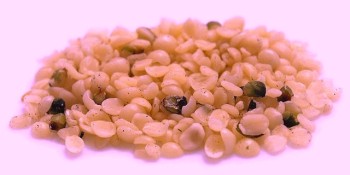
Banana Coffeecake with Hemp Seed Streusel
This is one of the most moist and delicious coffeecakes I’ve tasted! Hemp hearts make the perfect nutty and crunchy streusel topping. You can find Raw Shelled Hemp Seed (hemp hearts) at Trader Joe’s, Whole Foods, your local health food store or online.
3/4 cup all-purpose flour
1 teaspoon baking powder
1/2 teaspoon baking soda
Scant 1/4 teaspoon salt
1 teaspoon cinnamon
3 tablespoons butter, melted and cooled a bit
3/8 cup organic sugar
1 large egg
1 super-ripe large banana, well-mashed
Hemp Seed Streusel (recipe follows)
Preheat oven to 375°F
Lightly butter bottom and partially up sides of a 9-inch round cake pan. Set aside.
Make streusel (recipe follows) set aside.
In a large bowl, whisk together flour, baking powder, baking soda, salt and cinnamon. Set aside.
In a medium bowl, combine butter with sugar, beat in egg and mashed banana.
Add wet ingredients to bowl with dry ingredients and mix until just combined.
Pour batter into prepared pan. Pour streusel evenly over top surface and pat in lightly.
Bake 20 to 25 minutes, or until a tooth pick or cake tester inserted in center comes out clean.
Let cool in pan and cut into 6 wedges.
Makes 6 servings.
Hemp Seed Streusel
3/4 cup hemp hearts
1/4 cup all-purpose flour
1/4 cup organic sugar
2 tablespoons butter, softened
1/2 teaspoon ground cinnamon
1/8 teaspoon ground nutmeg
Combine ingredients in a bowl and mix with a fork, then fingers, until fully combined and crumbly.
Posted in Uncategorized | Comments Off on To the Nth Degree |
March 31, 2015
“To quote another gospel, Dune, by Frank Herbert, ‘Fear is the mind killer.’
To stay mindful, you have to not live in fear.”
~ Stephen Colbert

What if money actually did grow on trees?
Spring is here. Outside my window, the big tree, barren of leaves for the last three months, has just begun to show new growth. Its companion, on the other side of the house, went from bear to bull in a much shorter time period. That tree lost all of its leaves within a few days and, seemingly overnight, was covered again in abundant greenery.
Nature has cycles. Winter’s landscape is often bare, dry and cold. Spring follows with seeds and sprouts. Sweet, ripe fruits and abundant sun fill our summer days. And the harvest of fall allows us to put aside for the return of winter’s frugality.
If money grew on trees, acorns were chunks of precious metal, and leaves were dollar bills, would we remain faithful, gazing upon winter’s bare branches, of the eventual return of abundance?
Just as our gardens have seasons of plenty and seasons of scarcity, so do our budgets. Sometimes the tree is green and growing and at other times it appears bare and dry. Growth is not forever here, nor forever gone. The same is true for stagnation. Give thanks for the miracles of each season.
“And could you keep your heart in wonder at the daily miracles of your life, your pain would not seem less wondrous than your joy;
And you would accept the seasons of your heart, even as you have always accepted the seasons that pass over your fields.”
~ Kahlil Gibran
~~~~~~~~~
Green Fava Bean Falafel is a super yummy twist on the traditional chickpea version.

Green Fava Bean Falafel
Crispy outside, moist and tender inside, these falafel made with tender green fava beans are absolutely delicious all by themselves as snacks or appetizers or inside a pita for lunch. Trader Joe’s has Italian shelled fava beans in a 14 oz bag in the frozen case. Let the bag defrost in the fridge overnight, then pinch a hole in each skin and pop it off the bean, discarding the skins. This takes a bit of time, but its worth it.
14 oz bag of frozen shelled fava beans, defrosted and skinned
(you should have a scant 2 cups after skinning)
1/4 teaspoon dried turmeric
1/4 teaspoon Spanish smoked paprika
1 teaspoon fresh lemon juice
1/2 teaspoon cumin
1/4 teaspoon garlic powder
1/2 teaspoon lemon zest
1/4 cup chopped fresh chives
1/8 teaspoon salt (or to taste)
2 teaspoons all-purpose flour
2 cups (or more) vegetable oil for frying
Combine the skinned fava beans, turmeric, paprika, lemon juice, cumin, garlic powder, lemon zest and chives in a blender or food processor. Process until roughly mashed (you want some of the mixture creamy with some chunky pieces). Add 2 to 4 tablespoons of water to facilitate the blending, but only as much as needed. Add salt to taste and mix a bit more.
Spoon mixture into a bowl and stir in the flour. The mixture will seem wet.
Form into small 1-inch sized balls and place on a tray as you go. Chill balls in fridge for about an hour.
To fry:
Heat enough oil in a small heavy pan with deep sides so that it is about 1 inch deep. You can test the oil temperature by dropping in a kernel of popping corn. When it pops, scoop out the popped corn, the oil is ready. Alternatively, you can insert the handle of a wooden spoon into the oil. When bubbles form around the spoon and float to the top, the oil is ready.
Using a slotted spoon, carefully lower one ball at a time into the oil. Hold the slotted spoon with the ball in the oil for about 30 seconds, then drop the ball from the spoon, releasing it fully into the oil. Only fry about 3 at a time. If you try to fry too many at once, your oil temperature will drop and the balls may not hold together.
Fry balls until crispy brown on the outside. Drain on paper towels.
These are delicious by themselves. You can also serve as a sandwich in a pita with lettuce or sprouts, tomato, mayo, yogurt or tahini sauce and hot sauce.
Makes about 12 falafel. Serves 3 to 4
Posted in Uncategorized | 2 Comments » |
March 16, 2015
“In a gentle way, you can shake the world.”
~ Mahatma Gandhi

Spring is almost here, the time of planting, rebirth, fresh starts and new beginnings.
Gardeners know that before one can sow the seeds of spring, one must aerate the hardened winter soil by breaking through the top layer and turning over fresh earth. This shaking up of the old surface to create a new one is not only necessary for birthing new plants, but also new ideas, new habits and new possibilities.
It’s time to shake up your old habits to make way for the new. This week, pick one new thing you will try for Spring. No need to be grand, dramatic or drastic. As Edward Lorenz, the mathematician who coined the term “butterfly effect” proved, sometimes the smallest change can ultimately make a big difference.
Here are some ideas:
When you return home from your day, walk around the block instead of switching on the TV, tablet or computer.
Stop on your way home from work or errands and take a stroll in an unfamiliar neighborhood.
Try one new food or cuisine each week.
Wear a color you normally avoid or choose an article of clothing that’s been sitting unworn in your closet.
Watch a documentary about a part of the world you’ve never visited or know little about.
If you regularly add salt or pepper to your prepared food, try leaving it out for one week.
If you drink soft drinks, switch to iced herbal tea, or sparkling water with a splash of juice.
Try a new fruit or vegetable.
Listen to a genre of music that you think you don’t like.
Look up how to say “Thank you” in three languages you don’t know.
Set aside one day a month to be “technology-free”.
~~~
Make some shaken (not whipped) cream.

Shaken Cream
Shake up the way you whip cream. No beaters, no bowl, no blender – whipped cream is easy, fast and fun to make in a mason jar. Best of all, it’s a great workout for your abdominals!
You will need a quart-sized mason jar with lid.
8 oz organic heavy whipping cream
1/2 teaspoon vanilla extract
1/8 cup powdered sugar
Make sure the whipping cream is well-chilled.
Place the mason jar in the freezer for about 10 minutes.
Remove jar from freezer. Pour the chilled cream into the jar with the sugar and vanilla and seal the lid.
Shake the jar vigorously until cream is desired thickness.
I like my whipped cream very thick, so I shook my jar about 7 minutes. I have heard some people say it only took them one minute. It is a good idea to check the thickness of the cream every minute or so, so that you don’t shake it too much and end up making butter.
When cream reaches the desired thickness, use in your favorite dessert.
Store leftover shaken cream in the fridge in the same jar you made it.
Posted in Uncategorized | Comments Off on Shake it Up |
March 4, 2015
“You may have the Universe, if I may have Italy.”
~ Giuseppe Verdi
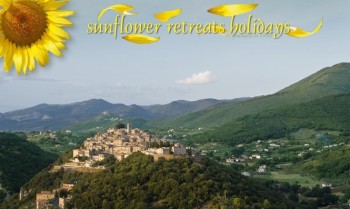
Spring will soon be here, the time of new beginnings.
After the exhale that is the fall season, and the pause before inhaling that winter symbolizes, spring is the time of the year when we begin to draw a new breath.
Spring is potential. Spring is possibility. Spring is the first expansion of Pranayama.
Pranayama is a Sanskrit word combining prana, meaning “breath” or “life force” and ayama, meaning “control”. Conscious breathing, the practice of Pranayama, is fundamental, not only to the practice of yoga, but to the practice of being alive.
Primavera is the Italian word for spring. Can you imagine taking a breath of fresh, spring air while sitting atop a hillside in the heart of beautiful Italy?
Imagine practicing Pranayama Primavera.
June 4th – 10th, as well as June 11th – 17th, I will be teaching yoga at Sunflower Retreats in beautiful Casperia, Italy, an idyllic medieval hilltop village, located just one hour outside of Rome.
Sunflower Retreats has been offering yoga holidays for the mind, body and soul since 1998. Yoga classes are held on an outdoor deck surrounded by trees. Guests can also enjoy the sauna and book massages and other holistic therapies. Nearby restaurants serve delicious food made from locally-sourced ingredients. Available activities include bicycle riding, swimming, therapeutic hot springs, mountain walks, cooking classes, painting classes, and more. Spending a week at Sunflower Retreats will be a chance to escape, unwind, enjoy, relax and renew – an opportunity to draw a fresh breath of inspiration.
The word inspire derives from the Latin inspirare, a combination of in, for “into” + spirare, “to breathe”. Although the modern definition of the word is given as, “to affect, guide or arouse, as if by divine influence”, the original meaning was “to breathe into or blow upon; to infuse life by breathing”.
The timeless and breathtaking beauty of Italy has inspired great painters and sculptors such as Leonardo da Vinci, Botticelli, Michelangelo and Bernini; composers such as Verdi and Paganini; the poetry of Dante and the films of Fellini and Sorrentino. What could inhaling the spring air of the Italian countryside inspire in you?
To imagine the possibilities of spending the end of this year’s spring season with me in Casperia, Italy, visit the Sunflower Retreats website at sunflowerretreats.com
~~~~~~~~~
Sunflower Seed Butter Cookies are a scrumptious way to celebrate the Sun and a delicious alternative cookie for those with peanut allergies. This recipe is a favorite selection from my book, Cooking and Mysticism: Year One of the Philosopher’s Spoon Blog.

Sunflower Seed Butter Cookies
Sunflower Seed Butter is just like peanut butter, only made with sunflower seeds instead of peanuts. You can find sunflower seed butter at Trader Joe’s, Whole Foods, other health food stores and online. You can also make your own using sunflower seeds, oil, salt, sugar and a food processor or blender.
1 & 1/4 cups all-purpose flour
1/2 teaspoon baking soda
1/2 teaspoon salt
1/2 teaspoon cinnamon
1 & 1/2 sticks (3/4 cup) butter, softened
1/2 cup organic granulated sugar
1/2 cup organic brown sugar
1/2 cup sunflower seed butter
(stir well before measuring)
1 large organic egg
1 teaspoon vanilla extract
Preheat oven to 375°F
Combine flour, baking soda, salt and cinnamon in a small bowl. Set aside.
In a larger bowl, cream butter, sugars and sunflower seed butter until smooth. Beat in the egg and vanilla.
Gradually add flour mixture into sunflower butter mixture. Beat until combined.
Drop by rounded tablespoon onto ungreased baking sheets, about 2 inches apart. Bake 8 to 10 minutes. For big cookies: use two tablespoons dough and bake for 10 to 12 minutes. Remove cookies from oven and let stand for 2 to 3 minutes. Then remove cookies from pan to cool on a wire rack or clean sheet of foil.
Makes 2 or 3 dozen cookies.
Posted in Uncategorized | 2 Comments » |
February 24, 2015
“There is not such a cradle of democracy upon the earth as the Free Public Library, this republic of letters, where neither rank, office, nor wealth receives the slightest consideration.”
~ Andrew Carnegie

I often take a walk around my neighborhood, both for exercise and to daydream. The other day I was heading down a local street and saw something at the edge of a neighbor’s front lawn that hadn’t been there the last time I passed by. A small box with glass doors in the shape of a little library sat atop a wooden post stuck into the grass at the edge of the sidewalk. “Take a book; leave a book” read a small sign on the front. This Little Free Library was filled with previously read and obviously well-loved books. How cool! I thought. I remembered having seen a story somewhere about these community book-sharing boxes. I was delighted to have one nearby.
In 2009, Todd Bol, a man in Wisconsin, built a small replica of a one-room schoolhouse, placed it on a post in his front yard, and filled it with books to share. He built the miniature library as a tribute to his schoolteacher mom, who loved to read. The little library was such a hit with neighbors and friends that Todd built and gave away several more.
It wasn’t long before Bol and his friend Rick Brooks, of the University of Wisconsin-Madison, decided to promote literacy and the love of reading by building and sharing these tiny free book exchanges around the world. Inspired by Andrew Carnegie, who founded 2,509 libraries in the late 19th and early 20th centuries, they turned their backyard project into a movement and, in 2012, Little Free Library was established as a non-profit organization.
From their website:
A Little Free Library is a “take a book, return a book” gathering place where neighbors share their favorite literature and stories. In its most basic form, a Little Free Library is a box full of books where anyone may stop by and pick up a book (or two) and bring back another book to share.
As of January 2014, the total number of registered Little Free Libraries around the world was estimated to be at least 15,000.
You can build or buy a Little Free Library for your neighborhood. Go to littlefreelibrary.org for more info. You can also watch a short video on how Little Free Libraries work by clicking here.
~~~~~~~~~
Happy Chinese New Year! Celebrate the Year of the Goat by making some Homemade Goat’s Milk Ricotta.

Homemade Goat’s Milk Ricotta
Homemade “ricotta” is easy to make yourself. Ricotta cheese is traditionally made by heating the whey that is left over from making other cheeses. This simpler method uses warmed whole milk, salt and vinegar to form the curds and only takes about 30 minutes or less of your time to make (most of which is simply waiting). Using goat’s milk instead of cow’s milk makes for an interesting flavor and a special treat that your lactose-intolerant friends will appreciate. I found grass-fed, humanely-raised goat’s milk at my local Trader Joe’s.
Note: whether you use goat’s milk or cow’s milk, check the label to make sure the milk is pasteurized, but not ultra-pasteurized. Sometimes the ultra-pasteurized milk will not form the curds properly.
4 cups whole goat’s milk
1/2 teaspoon sea salt
3 tablespoons distilled white vinegar
You will need a medium to large sized mesh strainer and
A piece of fine cheesecloth (strong paper towels may be substituted)
In a large, heavy soup pot or saucepan, over medium heat, heat milk and salt until milk just begins to simmer (milk will be foamy around the edges and tiny bubbles will begin to form on the surface, but it will not be boiling).
Remove pan from heat. Add vinegar and stir only once or twice, until you see curds begin to form. Do not stir past this point! Let stand a full minute.
Line a mesh strainer with a piece of clean cheesecloth and place this over a large bowl (you can use a strong paper towel for this purpose in a pinch, if you don’t have any cheesecloth on hand).
Slowly pour the liquid and curds into the cheesecloth. Make sure the strainer is not sitting in the liquid, so that it can continue to drain freely. If necessary, you can pour the excess liquid (whey) into another container (you will want to save this for another use). Do not disturb/stir the curds.
Let the curds drain over the bowl for about 12 to 35 minutes, depending on whether you desire a moist or a dryer texture for the ricotta (goat’s milk makes smaller curds than cow’s milk and takes a bit longer to drain).
Spoon the cheese into a bowl and let it come to room temperature. Use immediately in a recipe (lasagne, manicotti, cannoli, etc.) or cover and refrigerate for up to 5 days.
You can mix in a little extra virgin olive oil or mayo, along with some fresh herbs and a pinch of salt and pepper. Basil pesto is also a nice addition. Serve this as an appetizer with chips or crackers, as an addition to a salad, or spread on a sandwich.
Note: save the leftover liquid and add it to your pasta cooking water or the liquid you use to make rice or soup. This will add a nice flavor.
Makes about 1 & 1/2 cups
Posted in Uncategorized | Comments Off on A Little Free Library |
February 13, 2015
“The most beautiful things in the world cannot be seen or even touched, they must be felt with the heart.”
~ Helen Keller

Valentine’s Day is the day in which we celebrate matters of the heart. Whether you look forward to Valentine’s Day or would rather avoid it, a lovely way to harmonize your mind, body and soul within the context of your heart is with the Anjali Mudra.
Often used as part of a yogic meditation, mudras are gestures of the hands that symbolize and encourage various mental, spiritual and energetic states and are thought to help manifest these states into physical reality.
The verb manifest, defined as “to make evident”, probably originated as a combination of manus, the Latin word for “hand”, combined with festus, meaning “struck”. Therefore, the etymological roots of the word manifest describe striking a pose with the hand, as in forming the gesture of a mudra.
The Anjali Mudra is made by bringing your palms together in front of your heart center, with the thumbs resting lightly at the sternum. This positioning of the hands is used as both a greeting and a sign of respect in India and other parts of Asia. It is familiar to westerners as bringing the hands together in prayer.
Anjali, in Sanskrit, means “offering” or “salutation”. Mudra translates as “seal” or “gesture”. The Anjali Mudra can be interpreted as “to seal an offering” or “to make a gesture of salutation”.
In certain cultures, as well as in western yoga classes, this gesture of salutation is often accompanied by speaking the word namaste which can be translated as, “the divine in me salutes the divine within you.”
The heart is the center of the physical body, through which all blood flows. Energetically, the heart center is where the earthly, emotional, creative, mental and spiritual elements meet. Placing the hands at the heart center when greeting another person physically signifies that your heart is opening to acknowledge, not only the universal beauty and love within yourself, but also within them. One seals this offering of universal love by bringing the palms together to touch.
This hand positioning is also beneficial as an individual exercise. Bringing the hands together in this way connects physically, energetically and symbolically, the two hemispheres of the brain as well as the right and left sides of the body. It is the most fundamental of balancing postures.
Touching the palms together at the heart also helps to connect the inner self with the outer self. By forming the Anjali Mudra as part of a silent meditation, you are acknowledging the divine within your own heart as well as the universal love that exists within all things both greater and smaller than yourself, while symbolically and energetically sealing the connection.
No matter how you celebrate Valentine’s Day, you can make every day a celebration of love by combining the Anjali Mudra with six minutes of slow, deep breathing. Here’s how:
Sit or stand comfortably. Inhale deeply through your nose as you bring your palms together at your heart center. Rest your thumbs lightly at your sternum. Exhale slowly, again through the nose. Close your eyes and continue breathing in and out, slowly, evenly and deeply, preferably in and out of the nose. Do this for six minutes. If your mind begins to wander, imagine a beautiful rosebud as you inhale and see it opening slowly into full bloom as you exhale.
“The goal of life is to make your heartbeat match the beat of the universe, to match your nature with Nature.”
~ Joseph Campbell
~~~~~~~~~
You will love Red Velvet Cheesecake Brownies.

Red Velvet Cheesecake Brownies
These yummy brownies combine creamy red velvet cheesecake with a chewy, chocolatey brownie. I used natural food coloring (available at Whole Foods and online), which is not as intense as artificial food color, so the cheesecake part of my brownies was more of a pink velvet, but just as lovely and delicious for Valentine’s Day!
Red Velvet Cheesecake Filling:
8 oz full-fat cream cheese, softened
1/3 cup organic sugar
1/2 teaspoon vanilla
1 large egg
1 teaspoon (or more) red food coloring
Brownie batter:
2/3 cup all-purpose flour
1/2 teaspoon baking powder
1/4 teaspoon salt
1 cup organic sugar
1/2 cup (1 stick) butter, softened
2 large eggs
1 teaspoon vanilla
1/2 cup cocoa powder
Preheat oven to 350°F
Lightly butter the bottom and partially up sides of an 8-inch square pan.
Combine cheesecake filling ingredients in a food processor. You can also use a medium bowl with an electric mixer. Mix on low speed, then medium, then high, until creamy. Set aside.
In a large bowl, combine flour, baking powder and salt.
In another bowl, cream sugar and butter, then beat in eggs, then vanilla, then cocoa. Mix well.
Combine wet and dry ingredients.
Set aside 1/2 cup of the brownie batter.
Spread the remaining brownie batter in the bottom of the prepared pan. Top with the cheesecake filling and spread over the brownie layer evenly. Dot spoonfuls of the reserved brownie batter over the cheesecake layer. Run a knife over the surface to create a swirl pattern.
Bake for 40 to 45 minutes, or until top is just set.
Let cool completely and cut into squares.
Makes 16 brownies.
Posted in Uncategorized | Comments Off on Sealed with a Bliss |






























Recent Comments